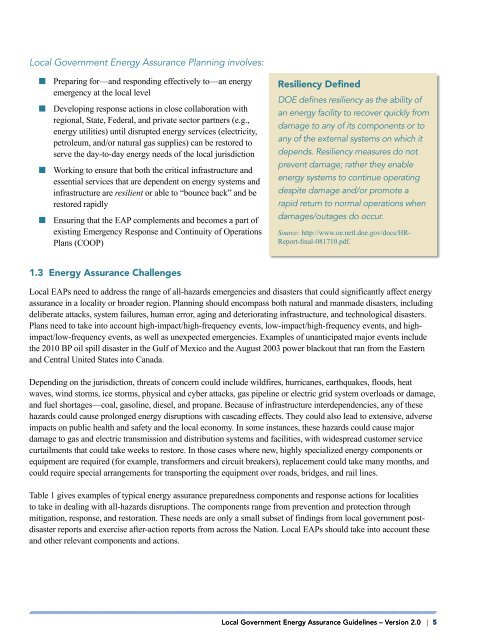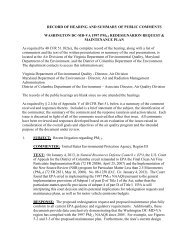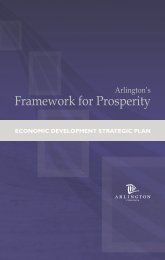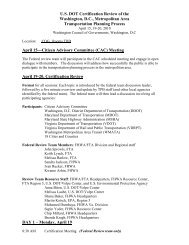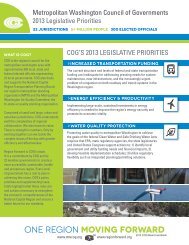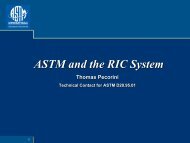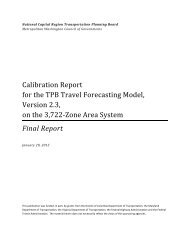PTI Local Government Energy Assurance Guidelines - Metropolitan ...
PTI Local Government Energy Assurance Guidelines - Metropolitan ...
PTI Local Government Energy Assurance Guidelines - Metropolitan ...
You also want an ePaper? Increase the reach of your titles
YUMPU automatically turns print PDFs into web optimized ePapers that Google loves.
<strong>Local</strong> <strong>Government</strong> <strong>Energy</strong> <strong>Assurance</strong> Planning involves:<br />
■■<br />
■■<br />
■■<br />
■■<br />
Preparing for—and responding effectively to—an energy<br />
emergency at the local level<br />
Developing response actions in close collaboration with<br />
regional, State, Federal, and private sector partners (e.g.,<br />
energy utilities) until disrupted energy services (electricity,<br />
petroleum, and/or natural gas supplies) can be restored to<br />
serve the day-to-day energy needs of the local jurisdiction<br />
Working to ensure that both the critical infrastructure and<br />
essential services that are dependent on energy systems and<br />
infrastructure are resilient or able to “bounce back” and be<br />
restored rapidly<br />
Ensuring that the EAP complements and becomes a part of<br />
existing Emergency Response and Continuity of Operations<br />
Plans (COOP)<br />
Resiliency Defined<br />
DOE defines resiliency as the ability of<br />
an energy facility to recover quickly from<br />
damage to any of its components or to<br />
any of the external systems on which it<br />
depends. Resiliency measures do not<br />
prevent damage; rather they enable<br />
energy systems to continue operating<br />
despite damage and/or promote a<br />
rapid return to normal operations when<br />
damages/outages do occur.<br />
Source: http://www.oe.netl.doe.gov/docs/HR-<br />
Report-final-081710.pdf.<br />
1.3 <strong>Energy</strong> <strong>Assurance</strong> Challenges<br />
<strong>Local</strong> EAPs need to address the range of all-hazards emergencies and disasters that could significantly affect energy<br />
assurance in a locality or broader region. Planning should encompass both natural and manmade disasters, including<br />
deliberate attacks, system failures, human error, aging and deteriorating infrastructure, and technological disasters.<br />
Plans need to take into account high-impact/high-frequency events, low-impact/high-frequency events, and highimpact/low-frequency<br />
events, as well as unexpected emergencies. Examples of unanticipated major events include<br />
the 2010 BP oil spill disaster in the Gulf of Mexico and the August 2003 power blackout that ran from the Eastern<br />
and Central United States into Canada.<br />
Depending on the jurisdiction, threats of concern could include wildfires, hurricanes, earthquakes, floods, heat<br />
waves, wind storms, ice storms, physical and cyber attacks, gas pipeline or electric grid system overloads or damage,<br />
and fuel shortages—coal, gasoline, diesel, and propane. Because of infrastructure interdependencies, any of these<br />
hazards could cause prolonged energy disruptions with cascading effects. They could also lead to extensive, adverse<br />
impacts on public health and safety and the local economy. In some instances, these hazards could cause major<br />
damage to gas and electric transmission and distribution systems and facilities, with widespread customer service<br />
curtailments that could take weeks to restore. In those cases where new, highly specialized energy components or<br />
equipment are required (for example, transformers and circuit breakers), replacement could take many months, and<br />
could require special arrangements for transporting the equipment over roads, bridges, and rail lines.<br />
Table 1 gives examples of typical energy assurance preparedness components and response actions for localities<br />
to take in dealing with all-hazards disruptions. The components range from prevention and protection through<br />
mitigation, response, and restoration. These needs are only a small subset of findings from local government postdisaster<br />
reports and exercise after-action reports from across the Nation. <strong>Local</strong> EAPs should take into account these<br />
and other relevant components and actions.<br />
<strong>Local</strong> <strong>Government</strong> <strong>Energy</strong> <strong>Assurance</strong> <strong>Guidelines</strong> – Version 2.0 | 5


